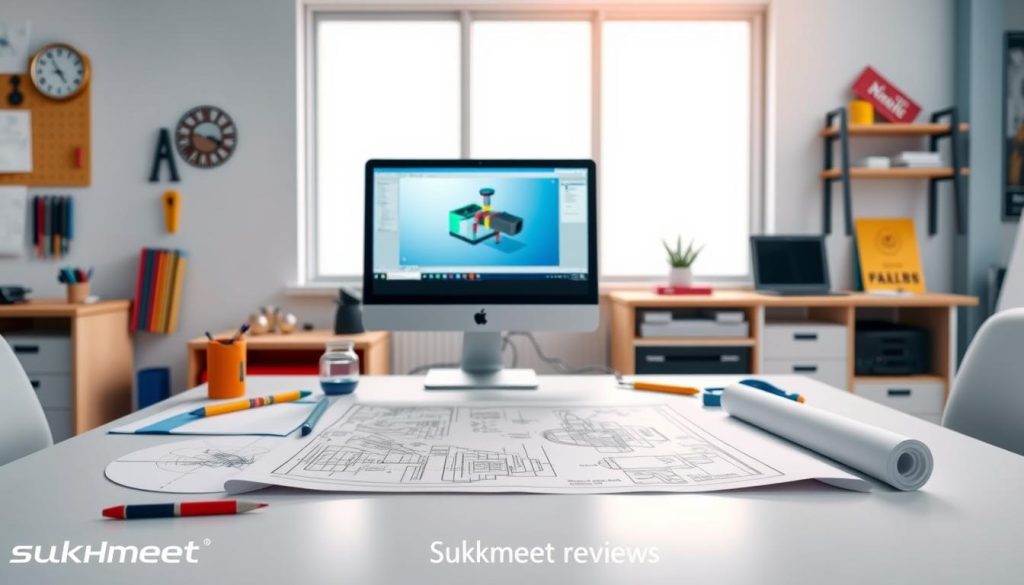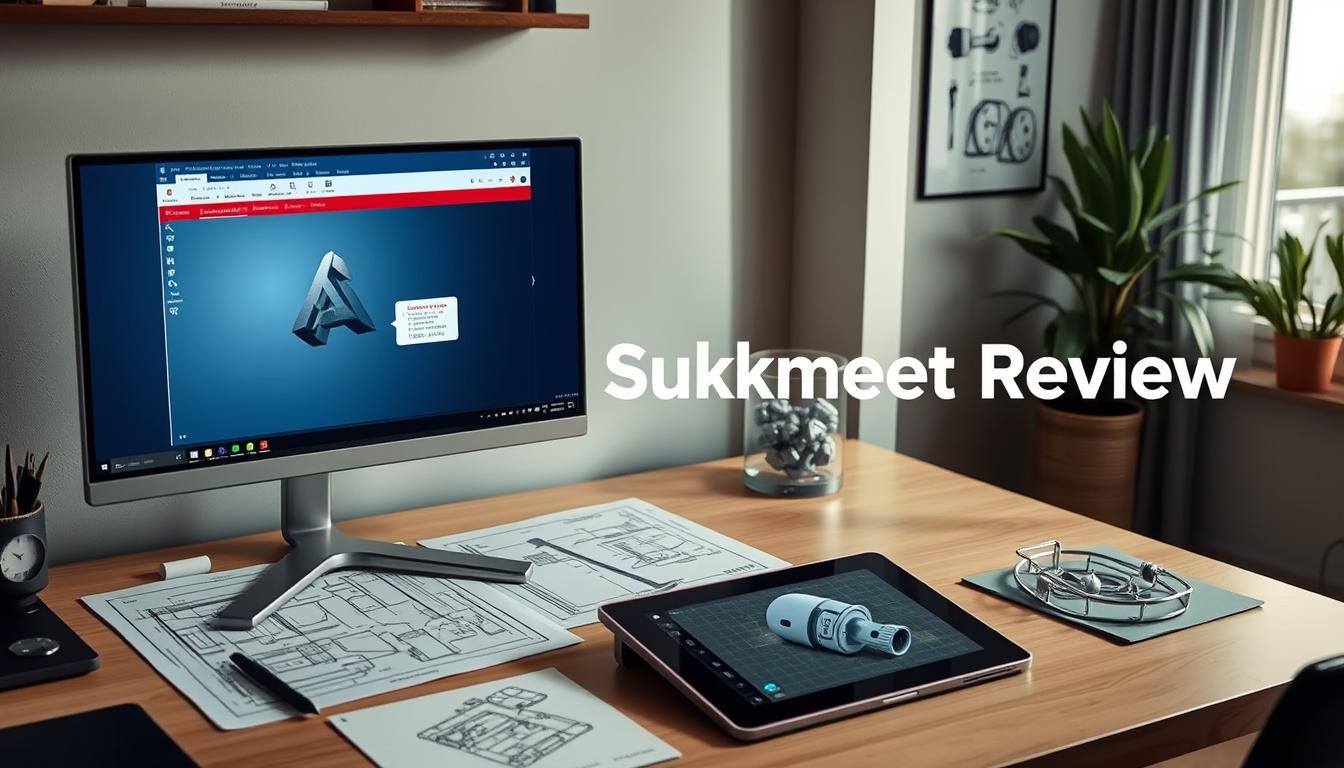Welcome to our detailed SolidWorks tutorial for beginners. It’s designed to help you get started with Computer-Aided Design (CAD). This guide will teach you the basics and how to use SolidWorks tools confidently. You’ll learn to complete your first project by following our easy steps.
This guide is great for anyone new to CAD software. It focuses on practical learning and using SolidWorks in real projects.
Key Takeaways
- SolidWorks is a powerful CAD software essential for modern design.
- This guide offers a step-by-step approach for beginners.
- You will learn the basics of SolidWorks installation and user interface.
- Gain practical experience by selecting a simple design project.
- Understand how to create and apply materials to 3D models.
- Shortcuts and tools will enhance your productivity in SolidWorks.
Introduction to SolidWorks for Beginners
Learning the basics of SolidWorks is key for anyone wanting to make professional designs and models. This part covers the essential parts for getting started with SolidWorks. It shows how CAD software is vital for design innovation.
What is SolidWorks?
SolidWorks is a top CAD software for 2D and 3D modeling. It’s easy to use and powerful, making it popular in engineering, architecture, and design. This introduction shows how it makes workflows smoother and helps teams work better together.
Importance of CAD in Design
CAD is very important in design. It turns ideas into precise digital models, making complex designs easy. With 3D views, teams can check designs before making them real. This saves time and money.
Overview of SolidWorks Features
SolidWorks has many features to make design easier for everyone. Key features include:
- Parametric modeling: Changes in one part update others automatically.
- Simulation tools: Test designs under different conditions.
- Rendering capabilities: Make designs look real for presentations.
- Extensive libraries: Use pre-made parts and assemblies in models.
These features help users learn SolidWorks fast. They build a strong base for advanced design and engineering.

Getting Started with SolidWorks
Starting with SolidWorks is easy if you follow a few steps. First, make sure you install it correctly. Then, check if your system meets the requirements. Knowing the user interface and how to navigate SolidWorks makes it easier to start.
Installation and System Requirements
Before you start, check if your computer meets the requirements. You need a Windows-based system and strong hardware. Here are the key specs:
- Operating System: Windows 10 or higher
- CPU: Multi-core processor, preferably Intel or AMD
- RAM: Minimum of 8GB (16GB recommended)
- Graphics Card: Dedicated GPU with OpenGL support
You can download SolidWorks from the Dassault Systèmes website. Students and faculty can also get educational licenses.
User Interface Basics
The SolidWorks user interface is easy to use. It has a command manager, task pane, and feature tree. These help you find tools quickly. Customizing these elements makes it even better.
Learning keyboard shortcuts also helps a lot. It makes your design work faster and more efficient.
Navigating the SolidWorks Environment
Knowing how to navigate SolidWorks is important. The layout of toolbars and workspaces is key. Here are some basic actions:
- Creating a new document
- Opening existing files
- Switching between different workspaces to streamline your workflow
Getting familiar with these elements improves your experience. It helps you use SolidWorks more effectively.

SolidWorks for Beginners: A Step-by-Step Guide to Your First Project
Starting a SolidWorks project can be exciting but also a bit scary for newbies. By following a simple plan, you can make your first design with ease. This guide will help you pick a simple project, learn to sketch, create 3D models, and add materials and textures.
Choosing a Simple Design Project
Beginners should start with a simple project. Good choices include a basic bracket, a simple cup, or basic shapes. These projects are great for learning the basics without getting too stressed.
Sketching Basics in SolidWorks
SolidWorks has many tools for sketching your designs. Learn about lines, arcs, circles, and dimensions. These are key for making your first sketches, which are the foundation of your 3D models.
Getting good at these basics is important for any beginner in CAD.
Creating 3D Models from Sketches
Turning your sketches into 3D models is the fun part. You’ll use tools like Extrude, Revolve, and Sweep. This guide will show you how to go from a flat sketch to a 3D object. It’s a great way to see your ideas come to life.
Applying Materials and Textures
After your model is shaped, adding materials and textures is key. Use the Material Editor to change how your model looks. This makes your design look real and helps you make it look good.
Read Also: Essential SolidWorks Tools: A Beginner’s Toolkit
Tips and Tricks for Efficient SolidWorks Use
Working efficiently in SolidWorks can make a big difference in your design work. Learning SolidWorks shortcuts and using the right tools can make your experience better. Knowing common mistakes can also help you work faster. Here are some tips to help you use the software better.
Shortcuts and Tools to Enhance Productivity
Using SolidWorks shortcuts can make your work flow smoother. Here are some key shortcuts:
- S – Activate the sketch tool.
- Ctrl + S – Save your work quickly.
- Ctrl + Z – Undo your last action.
- Spacebar – Open the view orientation menu.
- Ctrl + D – Toggle dimension visibility.
Using these shortcuts can make accessing commands faster. This helps a lot in making your projects better. Also, using the Property Manager and Workflow history helps track your actions. This makes designing easier.
Common Mistakes to Avoid as a Beginner
Knowing common mistakes in SolidWorks can save you a lot of time. Here are some mistakes to watch out for:
- Neglecting to fully define sketches can lead to unexpected results.
- Over-relying on automatic dimensions limits your ability to customize designs.
- Ignoring the order of features may result in flawed models.
- Failing to use the right units can cause inconsistencies in your dimensions.
Fixing these mistakes early on can make learning easier. By avoiding these issues, you can start your projects off right.
Conclusion
In this SolidWorks summary, we’ve covered the basics of using SolidWorks. You now have the skills and knowledge to start your CAD journey. It takes time and effort to master this powerful software.
With practice and a willingness to try new things, you’ll get better at design challenges. The SolidWorks beginner guide conclusion stresses the need for a structured learning approach.
Start with simple projects and move on to more complex ones. This will help you build your skills and confidence. Use the tips and resources from this guide to improve your experience and work more efficiently.
Remember, getting better at CAD design comes from practicing and exploring more. The more you use SolidWorks, the better you’ll get. This will help you unlock its full power.
FAQ
What is SolidWorks and who uses it?
SolidWorks is a powerful CAD software used in many fields. These include engineering, architecture, and product design. It helps users make accurate 2D and 3D models, making design easier.
How do I get started with SolidWorks as a beginner?
First, check if your computer meets the software’s requirements. Then, download SolidWorks from the Dassault Systèmes website. Learn the interface and start with basic tutorials or projects to build your skills.
Are there any recommended beginner SolidWorks tutorials?
Yes, many beginner SolidWorks tutorials are available online. They guide you through simple projects, sketching basics, and 3D modeling. These tutorials can really help you learn.
What types of projects should I start with in SolidWorks?
Start with simple projects that focus on basic skills. Try designing basic shapes or small objects like a bracket or cup. This will help you get familiar with SolidWorks.
What common mistakes should I avoid as a beginner in SolidWorks?
Beginners often make mistakes with sketch definitions, not enough dimensions, and wrong feature order. Make sure to define sketches and dimensions well to avoid problems later.
How can I improve my productivity when using SolidWorks?
To be more productive, learn and use keyboard shortcuts, customize your workspace, and use tools like the Property Manager. These tips can save you time and make your design work more efficient.
What resources are available for learning SolidWorks?
There are many resources for learning SolidWorks. You can find online courses, video tutorials, forums, and official documentation. Sites like Coursera and LinkedIn Learning offer courses, while forums offer support and advice from others.
Read Also:




